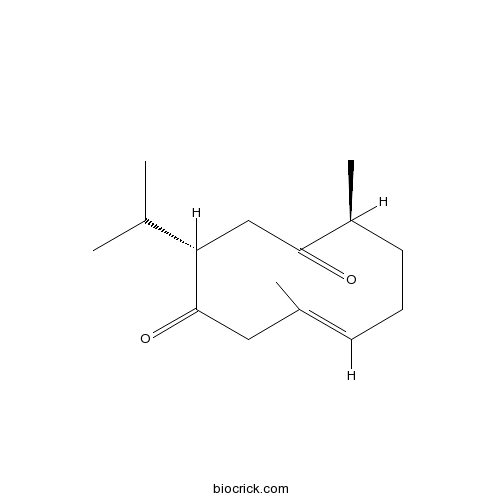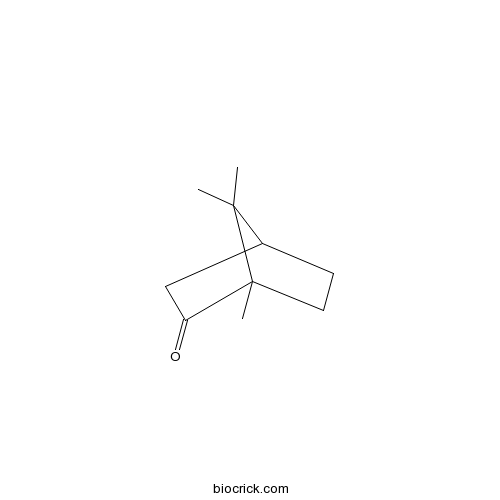Curcuma wenyujin
Curcuma wenyujin
1. The products in our compound library are selected from thousands of unique natural products; 2. It has the characteristics of diverse structure, diverse sources and wide coverage of activities; 3. Provide information on the activity of products from major journals, patents and research reports around the world, providing theoretical direction and research basis for further research and screening; 4. Free combination according to the type, source, target and disease of natural product; 5. The compound powder is placed in a covered tube and then discharged into a 10 x 10 cryostat; 6. Transport in ice pack or dry ice pack. Please store it at -20 °C as soon as possible after receiving the product, and use it as soon as possible after opening.

Natural products/compounds from Curcuma wenyujin
- Cat.No. Product Name CAS Number COA
-
BCN5936
Curdione13657-68-6
Instructions

-
BCN3522
Curcumenol19431-84-6
Instructions

-
BCN5974
Demethoxycurcumin22608-11-3
Instructions

-
BCN3526
Isocurcumenol24063-71-6
Instructions

-
BCN1257
Ethyl ferulate4046-02-0
Instructions

-
BCN5504
Curcumin458-37-7
Instructions

-
BCN5976
Curcumol4871-97-0
Instructions

-
BCN4981
Germacrone6902-91-6
Instructions

-
BCN8297
Camphor76-22-2
Instructions

-
BCN1265
Alismoxide87701-68-6
Instructions

[UPLC fingerprint and multi-components determination of three processed products of Rhizome of Curcuma wenyujin].[Pubmed: 29945381]
None
Quantitative analysis of sesquiterpenes and comparison of three Curcuma wenyujin herbal medicines by micro matrix solid phase dispersion coupled with MEEKC.[Pubmed: 29355994]
A simple, efficient and environmental friendly method was proposed for determining five sesquiterpenoids of Curcuma wenyujin by MSPD extraction coupled with MEEKC separation. Molecular sieve was applied as a solid support for extraction of sesquiterpenoids for the first time. Various parameters affecting extraction and separation efficiency were investigated. The optimized conditions involved dispersing sample (200 mg) with 200 mg of TS-1 for 150 s and using 1000 μL of methanol to elute five target analytes. Finally, they were well separated by using a running buffer containing 1.3% SDS, 5.0% 1-butanol, 0.5% ethyl acetate and 10% acetonitrile in 10 mM borate buffer at pH 9.0. Consequently, the developed method was fully validated and successfully applied to determine the five sesquiterpenoids including curdine, curcumenol, germacrone, furanodiene and β-elemene in Curcuma wenyujin origin's Chinese herbal medicines. Furthermore, hierarchical cluster analysis was performed based on the contents of target compounds for distinguishing steamed and non-steamed drugs. The present study provided a promising method for fast investigation and discrimination of chemical difference in steam & non-steamed Chinese medicines from Curcuma wenyujin origin.
β-elemene regulates endoplasmic reticulum stress to induce the apoptosis of NSCLC cells through PERK/IRE1α/ATF6 pathway.[Pubmed: 28672279]
Endoplasmic reticulum stress (ERs) has been regarded as an important cause for the pathogenesis of non-small-cell lung cancer (NSCLC). β-elemene is an active component in the essential oil extracted from a medicinal herb, Curcuma wenyujin, and has been reported to be effective against non-small-cell lung cancer (NSCLC). However, the potential effect and underlying mechanisms of β-elemene on regulating ERs to inhibit NSCLC are still unclear. In the present study, A549 cells and Lewis tumor-bearing C57BL/6J mice were established to evaluate this effect. Visualsonics Vevo 2100 Small Animal Dedicated High-frequency Color Ultrasound was performed to observe tumor volume in vivo. 3-(4,5-dimethylthiazol-2-yl)-2,5- diphenyltetrazolium bromide (MTT) was used to evaluate cell vitality of A549 cells. Furthermore, western blotting (WB), immunohistochemistry (IHC) and quantitative reverse transcription polymerase chain reaction (q-PCR) were applied to detect the ERs-related proteins. Flow cytometry was also applied to detect cell apoptosis and assay kit for reactive oxygen species (ROS) generation. Our results showed that β-elemene inhibited lung cancer tumor growth and cell vitality in a dose- and time-dependent manner. Not only that, β-elemene could up-regulate ERs-related proteins like PERK, IRE1α, ATF6, ATF4, CHOP and down-regulate the Bcl-2 expression. More importantly, ERs inhibitor 4-PBA, IRE1α inhibitor STF-083010, ATF6 inhibitor Anti-ATF6 and PERK inhibitor GSK2656157 can all reduce the amplitude of protein expression changes and apoptosis rates, then weaken the anti-tumor effect of β-elemene. Therefore, the present in vivo and in vitro study revealed that the anti-NSCLC effect of β-elemene is closely related to the activation of ERs through PERK/IRE1α/ATF6 pathway, and this might be beneficial for clinical therapy of NSCLC.


